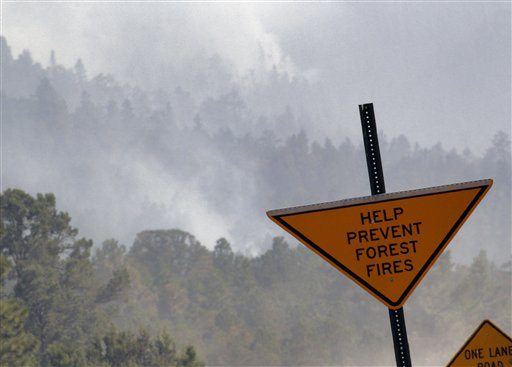LUNA, N.M. (AP) — An enormous wildfire in eastern Arizona is poised to become the largest in state history, as firefighters Tuesday tried to keep it from devouring a small New Mexico mountain town and authorities questioned two people about an abandoned campfire that may have started the blaze.
Fires also grew elsewhere in New Mexico and at the state’s border with Colorado, where flames forced the closure of a busy interstate highway.
Kelly Wood, a spokesman for the multiple agencies battling the massive Arizona fire, said late Tuesday that two people of interest were being questioned but he couldn’t provide any further details. The U.S. Forest Service might release more information about the investigation Wednesday, Wood said.
In Luna, N.M., just across the Arizona state line, evacuation plans were in place for the roughly 200 residents. Crews have been working to protect the town for days, hacking down brush, using chain saws to cut trees and setting small fires to burn anything that the approaching flames could use as fuel.
“That’s what’s saved the town,” fire incident command spokesman Sean Johnson said. “The line is holding.”
Fires have devoured hundreds of square miles in the Southwest and Texas since the wildfire season began several weeks ago. Scant winter precipitation in Arizona, New Mexico, part of west Texas and southern Colorado is blamed on La Nina, a term describing cooler waters in the equatorial Pacific Ocean that keep the jet stream from dipping down and bringing storms to the region.
Those storms instead dropped their rain and snow farther north, which has led to huge snowpack in the Sierra Nevada range in California and in the Rockies.
The wildfire outlook issued by the National Interagency Fire Center in Boise, Idaho, calls for above-normal fire potential in those areas through September, but normal or less than normal across the rest of the West.
The huge blaze in Arizona was also made worse by the extremely thick forest, the result of a century of fire suppression that has let more trees grow in the world’s largest ponderosa pine forest.
Fires that once scorched only grasses and small trees on the forest floor now reach into the crowns and skip across miles of terrain through the treetops. Forests across the West have similar problems.
The Arizona fire has burned more than 733 square miles since Memorial Day weekend and destroyed 32 homes and four rental cabins. It was 20 percent contained as of Tuesday night, Johnson said.
Arizona’s largest fire was the 2002 Rodeo-Chediski fire, which burned 732 square miles but destroyed far more buildings. That blaze northwest of the current fire burned 491 buildings and cost about $400 million to fight.
The current fire has surpassed the Rodeo-Chediski fire in size, but it still wasn’t considered Arizona’s largest fire as of Tuesday night because about 3,000 of the more than 469,000 acres that have burned were in New Mexico, where firefighters had intentionally set blazes to keep back uncontrolled flames, Johnson said. Officials expected the blaze to become Arizona’s largest by morning, he said.
The fire in the Apache-Sitgreaves National Forest was growing on all but its northern front, chewing up thousands of acres of forest a day.
Although the fire is enormous, other U.S. blazes between 1997 and 2009 have been much larger.
The biggest was a 2004 blaze in Alaska that burned more than 2,000 square miles. The largest in the continental U.S. were a 2006 Texas blaze that consumed 1,417 square miles, followed by a 2007 Idaho fire that burned 1,018 square miles.
About 2,700 people who live in several Arizona resort communities in the forest remained under an evacuation order. Fire officials said they were working to make the picturesque hamlets of Alpine, Nutrioso and Greer safe for residents to go home.
Wood said residents of Nutrioso will be allowed to return to their homes after 10 a.m. Wednesday.
It will take several more days, at least, to make the other towns safe, officials said.
Greer, considered the jewel of eastern Arizona’s summer havens, lost more than 20 homes and a couple dozen outbuildings as flames moved into the valley last week.
In New Mexico, near the Colorado border, a wildfire fanned by high winds has forced hundreds of people from their homes and grown to more than 38 square miles. The blaze near Raton was burning on both sides of Interstate 25.
That wildfire started Sunday on the west side of I-25 and jumped to the east side later that day. The highway’s closure sent summer motorists on lengthy detours. Fire officials said at least two structures had burned, but they couldn’t say what they were.
“It looks like your worst nightmare,” Raton Mayor Neil Segotta said.
Another wildfire in southern Colorado spread to about 1,800 acres and forced the evacuation of a church camp. Residents of 50 homes were told to evacuate and another 50 warned to do so, Custer County Sheriff Fred Jobe said Tuesday.
Another fire in southern New Mexico had burned about 1,500 acres near the Carlsbad Caverns and was threatening the visitor center and housing at the tourist destination.
Several other fires were burning around Arizona, including a huge blaze near the southeastern border town of Portal that has burned more than 267 square miles since May 8. It was about 60 percent contained. Another fire that broke out Sunday outside Sierra Vista near the Coronado National Memorial also forced evacuations.



